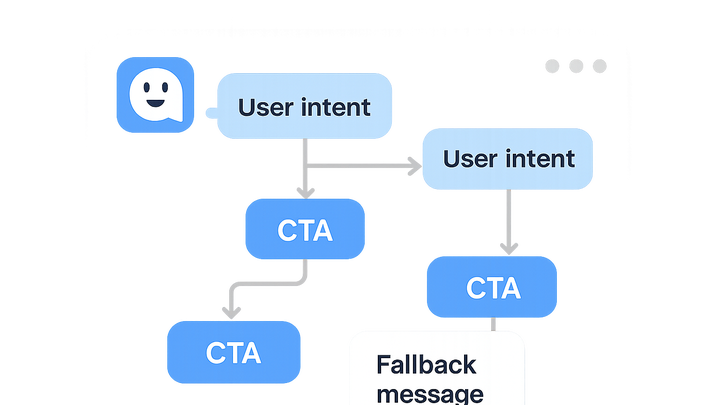Published on 2025-06-29T21:32:14Z
What Are Chatbot Scripts? Examples and Best Practices
Chatbot scripts are predefined conversational flows that guide user interactions on websites, playing a crucial role in conversion rate optimization (CRO), user experience (UX), and search engine optimization (SEO).
By anticipating user intents and structuring dialogue paths, scripts help qualify leads, answer queries, and navigate visitors towards desired actions without manual intervention.
Well-crafted scripts maintain brand voice, handle errors gracefully, and embed clear calls-to-action (CTAs) at strategic points.
Incorporating relevant SEO keywords and ensuring compliance with accessibility standards further enhances organic reach and inclusivity.
With tools like Prevue.me, teams can receive actionable critiques on their chatbot scripts to maximize lead generation effectiveness, improve user satisfaction, and boost website performance.
Chatbot scripts
Predefined conversational flows guiding users on websites to boost conversions, lead generation, UX, SEO, and accessibility.
Why Chatbot Scripts Matter in CRO, UX, and SEO
Chatbot scripts are more than simple Q&A flows; they are strategic assets that can significantly impact user experience, conversion rates, and search optimization on your website. A well-structured script anticipates user intent, reduces friction, and guides visitors to desired actions. From capturing leads to providing instant support, effective scripts serve multiple roles. They can also embed keywords and context that support SEO goals while ensuring the conversation remains accessible. Ultimately, precise scripting aligns chatbot interactions with broader business objectives, driving measurable growth.
-
Conversion funnel optimization
Chatbot scripts can be designed to guide users through each stage of the conversion funnel by asking qualifying questions and presenting CTAs at optimal moments.
-
Personalized user journeys
By mapping user intents and customizing responses, scripts create dynamic, individualized experiences, boosting satisfaction and reducing drop-offs.
-
Seo and accessibility integration
Incorporating relevant keywords in bot messages and ensuring scripts are screen-reader friendly helps maintain SEO value and WCAG compliance.
Key Components of Effective Chatbot Scripts
Creating an effective chatbot script involves several core components, each ensuring the conversation remains coherent, engaging, and aligned with your objectives. Breaking down the script into triggers, intents, messages, and fallback paths provides clarity for both developers and stakeholders.
-
Trigger conditions
Define what user actions, time on page, or events will initiate the chatbot conversation to target the right audience at the right moment.
- User behavior triggers:
Actions like clicking specific links, scrolling depth, or time spent can start the chat.
- Proactive vs. reactive:
Decide when the bot should proactively engage or wait for user input.
- User behavior triggers:
-
Intent mapping
Map out user goals (e.g., product inquiry, pricing, support) and script corresponding conversational paths to address each intent accurately.
- Primary vs secondary intents:
Distinguish between main user objectives and follow-up needs.
- Primary vs secondary intents:
-
Message tone and personality
Establish a consistent brand voice and tone that resonates with your target audience, whether formal, playful, or empathetic.
-
Fallback and error handling
Provide helpful fallback messages when the bot doesn’t understand, guiding users back to supported paths or escalating to human agents.
- Clarification prompts:
Ask follow-up questions to clarify user intent.
- Escalation paths:
Offer options to connect with live support if the bot fails.
- Clarification prompts:
Best Practices for Designing Chatbot Scripts
Following best practices ensures that your chatbot scripts are engaging, efficient, and aligned with user expectations and technical requirements.
-
Keep it concise
Use short, clear sentences to maintain momentum and avoid overwhelming users with too much information.
-
Use clear calls-to-action
Guide users toward desired outcomes by embedding CTAs like ‘Get a free quote’ or ‘Download now’ at strategic points.
-
Test and iterate
Continuously A/B test different script variations and refine based on user behavior analytics and feedback.
-
Optimize for seo and accessibility
Include relevant keywords naturally and ensure scripts adhere to accessibility guidelines for screen readers and keyboard navigation.
Examples and Critique with Prevue.me
Examining real-world examples helps illustrate effective script design. prevue.me can analyze your chatbot scripts to identify areas for improvement in CRO, UX, SEO, and accessibility.
-
Sample chatbot script for lead generation
A basic script that qualifies leads and collects contact information. See the code snippet below.
- Script example:
Bot: Hello! Ready to improve your website's conversion rates? User options: - Yes, show me how - No, thanks Bot: Great! Please share your email to get a free audit.
- Script example:
-
Prevue.me critique highlights
Key recommendations from prevue.me after analyzing the sample script.
- Enhance personalization:
Adjust the initial greeting to reference the user’s industry for a more tailored experience.
- Balance keyword usage:
Integrate SEO keywords subtly to avoid unnatural phrasing.
- Improve accessibility:
Add ARIA labels and ensure conversational elements are accessible via keyboard-only navigation.
- Enhance personalization:
